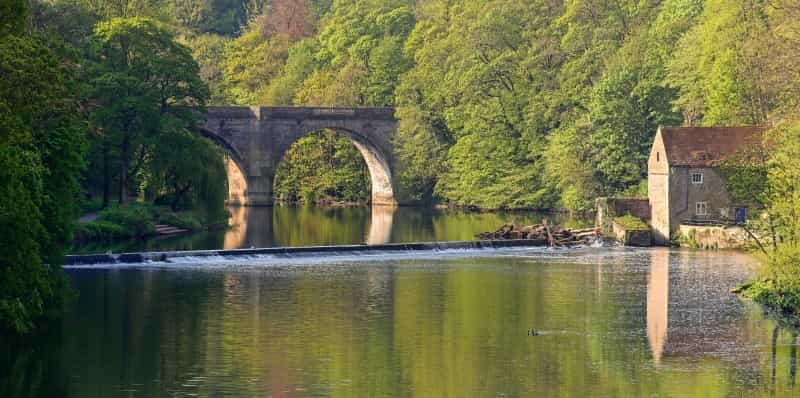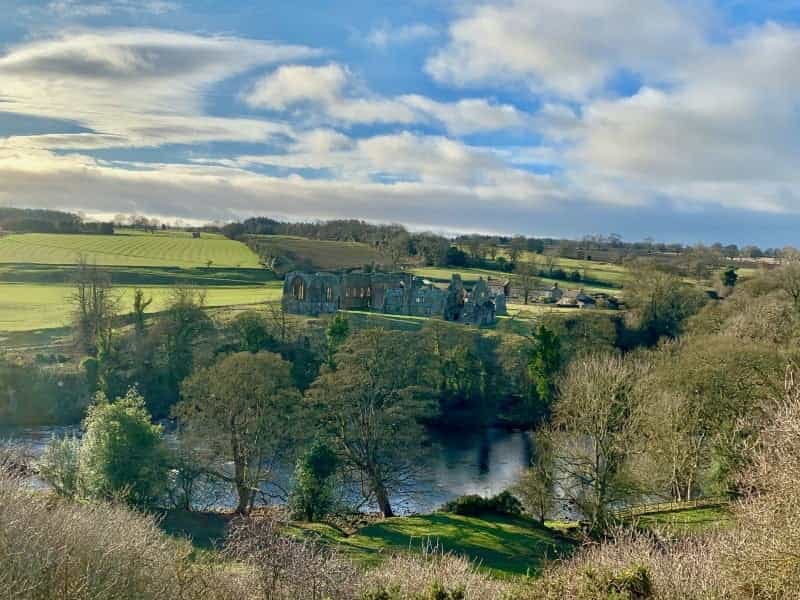Top 10 Best Scenic Walks In Durham
From the heritage coast in the east to the dales in the west, walks in County Durham pass through a rich landscape of rural villages, windswept moorland and river valleys that run to the sea.
Whether it’s a hike over rugged peaks, a stroll in the countryside or a walk taking in some of the area’s unique history, County Durham has some of the finest walking routes in the north to choose from.
Here are 10 of the best scenic walks in Durham.

Durham City riverbank walks
The city of Durham is a magnificent place to visit with cobbled streets winding their way up to the UNESCO World Heritage Site of its cathedral and castle.
Durham Cathedral is one of the finest examples of Norman architecture in Europe, occupying a rocky promontory in a bend of the River Wear along with its adjacent 1,000-year-old castle.
The best place to see this most celebrated and photographed site is from the riverbanks that meander along a shady tree-lined path below. You can make it a circular walk in Durham by crossing the Wear at any of the three mediaeval arched bridges or one of the more modern structures traversing the river. A visit to the cathedral, taking a boat out on the Wear and foodie feasts all feature in our rundown of the best things to do in Durham, so check them all out when you plan your day.
Search campsites to book in County Durham

Derwent Reservoir
High up in the hills above the town of Consett is Derwent Reservoir. Lakeside paths loop around the seven-mile shoreline, occasionally climbing gently into the surrounding woodland with places to stop off for a picnic or a paddle to cool your feet. Every vantage point looks out across the watery expanse that’s popular with yachters and anglers.
Find rural campsites near Consett and Derwentside
Beamish Woods
The fantastic Beamish Living Museum is surrounded by acres of mature deciduous woodland. Paths and tracks snake through the area, revealing hints of its agricultural and industrial past. You may well stumble across sculptures of cows made from old JCB parts, an old railway line that once carried coal to the coast, and the remains of a paper mill and drift mine. The nearby Shepherd and Shepherdess pub is a local landmark with tempting tastes of locally sourced fare once you’ve walked up an appetite.
Browse holiday parks and sites near Beamish
Low and High Force
This is a jaw-dropping five-mile circular walk in the Upper Teesdale area within the North Pennines Area of Outstanding Natural Beauty. The route takes in High Force, England’s biggest waterfall, and its no-less-impressive smaller sibling. The walk leads along the banks of the River Tees, crosses the old lead miners' Wynch Bridge, and passes through pretty woodland trails, picking up part of the Pennine Way footpath.
To make it a triple-waterfall delight, nearby Summerhill Force is equally worth a visit. It’s less well known (and quieter for it…) but Summerhill Force is a delightful spot with a waterfall cascading into a pool below in which the kids or dogs can splash. In a recess behind the falls is Gibson’s Cave – local legend tells the tale of an outlaw who hid here from the constables hunting him in the 16th century.
Find campsites near the waterfalls around Middleton-in-Teesdale
Killhope Woodland Walks
Killhope Lead Mining Museum is the most complete lead mining site in Britain. The giant wheel of the former mine looms into view as you climb the main road from St John’s Chapel through Cowshill to the remote spot. It’s hard to imagine nowadays that this place was once a hive of activity. The surrounding woodland has several trails running through it. You can even watch the colony of local red squirrels from one of the hides.
Explore Weardale from a camping base near Frosterley
Barnard Castle to Egglestone Abbey
Deep within the Tees Valley is the charming town of Barnard Castle. Set in a dip in the moors where the river has carved out an undulating gorge, ‘Barney’ (as it’s affectionately known) is dominated by the ruined towers of the fortress from which it takes its name.
The section of river from Barnard Castle to Egglestone passes by the remnants of ancient mills and a marble quarry with views of the spectacular Bowes Museum housed in an elegant French-style chateau. The route reaches Egglestone Abbey as the Tees burbles along between limestone bluffs and clefts (that’s cliffs and crevices for those who’ve forgotten their school geography lessons).
Search campsites near Barnard Castle

The Auckland Way
This is a trail of just over four miles that begins in the Bishop’s Park of Auckland Castle before routing along an old railway line that tells the history of this part of County Durham as it makes its way to Spennymoor. Bishop Auckland has been transformed in recent years with a new visitor centre built in an impressive tower at the entrance to the castle. Auckland Castle is just over the river from Kynren, the epic live historical show with outdoor attractions.
Auckland Castle was the official residence of the Bishops of Durham until it passed to a trust to manage as a tourist attraction in recent years. The surrounding parkland was used by the bishops for hunting. Good views can be had of the park and impressive deer shelter from the old terraced castle gardens.
Walk through the park and pick up the old railway line at the bottom near the River Gaunless, which leads along a flat route to Spennymoor. Remnants of railway history can be seen all along the way, including what may be the country’s only double bridge — built at this width and tree-lined because Bishop Lightfoot (1828-1889) reputedly hated the railways and wanted to see no sign of it.
Find cheap campsites near Bishop Auckland
Durham Heritage Coast
Not so long ago, the Durham coast was one big industrial landscape. For more than a century, massive pit shafts dominated the skyline with the beaches turned black under a layer of colliery spoil. In recent decades, the coastline has been transformed. Nature has reclaimed the area and what was once its rarest species – tourists – have returned.
The Heritage Coast walk stretches for 11 miles from the harbour town of Seaham to the cliffs at Crimdon. It makes for a scenic and easy coastal walk with much of the way very flat apart from the odd drop into dunes and wooded coastal denes.
Search the best campsites near Seaham and the County Durham coast

Hamsterley Forest
Hamsterley Forest is the largest woodland tract in County Durham and occupies two sides of a sheltered valley in mid-Weardale. There are waymarked routes throughout the broadleaved and coniferous forest suitable for walkers, cyclists and strollers of all abilities and hiking ambitions.
Hamsterley Forest is a great place for families. There are adventure playgrounds, bike hire and themed trails including a Gruffalo discovery route (with some fab wooden sculptures of the characters from the book), and a Viking-themed path with ship and castle keep play parks. For those looking for a peaceful ramble, it doesn’t take long to escape the crowds and get lost (almost) among the towering trees and moorland.
Find campsites close to Witton-le-Wear, not far from Hamsterley Forest
The Weardale Way and the Teesdale Way
The Durham Dales are two long green valleys formed by the two great rivers of the county that begin up in the Pennines before eventually finding their way to the sea. There are two long-distance walks that follow the Wear and the Tees. The Weardale Way and the Teesdale Way offer different perspectives of County Durham but both pass through lush valleys overlooked by fells, moorland and commons.
The Weardale Way is 79 miles long, and the lengthier Teesdale Way is 100 miles. Both eventually leave the boundaries of County Durham – the former as the Wear makes its way to the North Sea at Sunderland and the latter through the Tees Valley counties to the North Sea port just beyond Middlesbrough.
You can easily find guides to direct you along stretches of both, depending on where you’re staying in County Durham, or pick which section tickles your trail tastes.
The Land of the Prince Bishops as a holiday destination
County Durham is a vast territory intermingling history, heritage and varied landscapes that present something different for every day of a break here. From the wilderness of the North Pennines, through isolated settlements in pretty valleys, to the pomp of the Prince Bishops who to this day take their place at Durham Cathedral, the county remains a little unknown as a destination – which only adds to its appeal.
For walkers, the Durham coastal trail is quite possibly one of the finest and richest sections of the England Coast Path (it’s definitely the best sign-posted too). Check out our guide to County Durham’s best beaches for more info on what you’ll stumble across along the way.
Durham is easily reached from every corner of the north east of England. If you’re considering a camping holiday anywhere in the region then check out our camping guide to the North East before you book.

